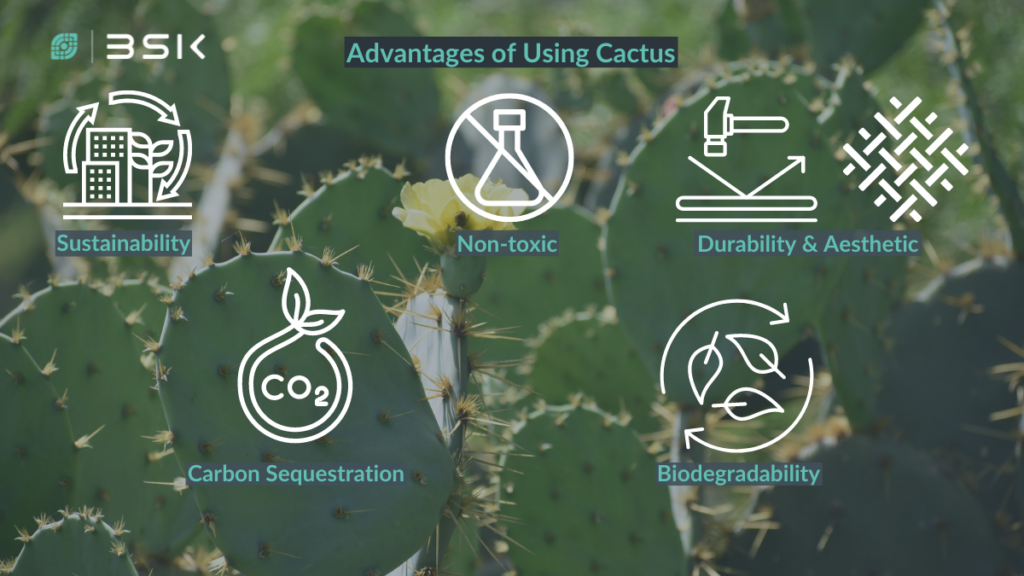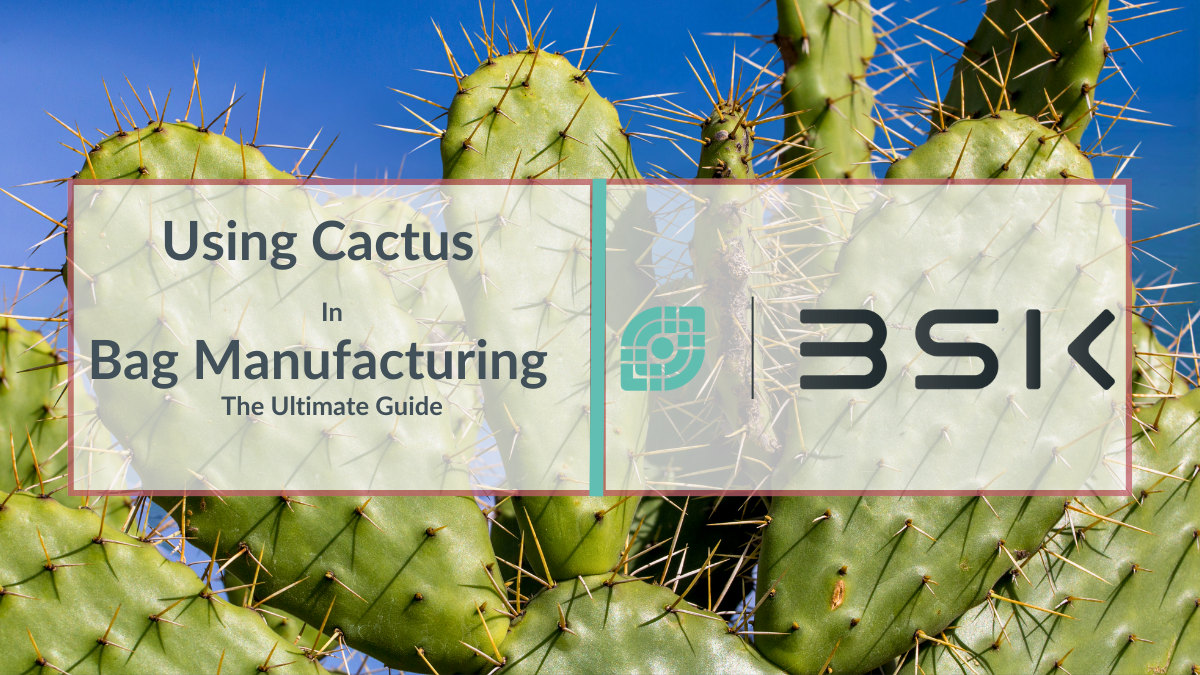Using cactus in bag manufacturing has answered the call for more plant-based alternatives to leather. A relatively new use of the arid, prickly plant has emerged within the fashion industry and beyond. It’s not just something to beautify living rooms; the manufacturing industry has also begun exploring this plant’s potential.
In an era where sustainability is both appreciated and required, the fashion industry is under the microscope for its environmental practices. Emerging among the innovative solutions to address these concerns, cactus leather shines as a trailblazer. Derived from the Nopal cactus, this sustainable material promises to revitalize fashion design and redefine our relationship with the environment. Join us in uncovering the evolutionary journey of cactus leather from a desert plant to a potential fashion staple, marking a pivotal shift towards an eco-conscious future.
Discover the Eco-Friendly Innovation of Cactus Leather
This vegan alternative to traditional leather is made from the leaves of the Nopal cactus plant. This organic, durable, strong material stands out for its high resistance to abrasion, rubbing, and tearing. Its production involves growing Nopal cactus plants without irrigation, herbicides, or pesticides, making it a sustainable choice. The leaves are transformed by cleaning, grinding, sun drying, and mixing with non-toxic chemicals to create smooth vegan leather. Cactus leather is water-resistant, breathable, and aesthetically pleasing, making it versatile for fashion items like shoes, furniture, and handbags.

Advantages of The Prickly Plant
Emerging as a promising alternative to traditional leather in the fashion industry. Its unique properties and sustainable production process offer distinct advantages for manufacturers and consumers. Additionally, the key benefits of utilizing cactus leather for bag production encompass:
Sustainability: Cactus leather is sustainable as Nopal cactus requires minimal water and no pesticides or herbicides, reducing environmental impact. It eliminates the need for irrigation, unlike traditional and faux leathers that involve high water consumption and chemical treatments.
Carbon Sequestration: Carbon sequestration presents a viable solution to combat climate change by removing carbon dioxide from the atmosphere. One innovative method involves leveraging natural processes, such as the photosynthesis of plants like the Nopal cactus, which absorbs CO2 efficiently. This approach not only aids in reducing greenhouse gas emissions but also contributes to sustainable agriculture and energy practices, showcasing a promising path towards environmental restoration and climate resilience.
Non-toxic Production: Contrary to traditional animal leather, which typically involves chromium tanning and releases toxic chemicals, cactus leather undergoes processing with non-toxic chemicals. This practice ensures a safer environment for industry workers and the planet.
Durability and Aesthetic Appeal: Cactus leather stands out for its durability, resistance to abrasion, rubbing, tearing, and soft texture. These qualities make it the perfect material for a wide array of bag styles, ranging from daily-use handbags to luxury purses. Its water-resistant feature further enhances its versatility and longevity.
Biodegradability: Specifically, the version produced by Desserto, cactus leather, has a 92% organic carbon content, making it highly biodegradable. This aspect addresses one of the major environmental concerns associated with synthetic leathers and blends of non-biodegradable materials.
Limitations of Cactus Leather
It is clear that using cactus in bag manufacturing has many benefits. It also faces a number of challenges and limitations in bag manufacturing.
Durability: Known for its durability, potentially lasting up to 10 years. However, this falls short compared to traditional leathers, which can endure for decades with proper care. This aspect may deter customers from seeking products with extensive longevity, potentially affecting their perception of value and utility.
Cost: The cost of cactus leather is comparable to that of animal leather. Given its novelty and early stage of development, cactus leather remains relatively expensive. Its high cost might limit its appeal to consumers looking for more affordable alternatives to traditional leather.
Environmental Impact: Although marketed as a sustainable choice, the production involves non-toxic chemicals and, if combined with synthetic materials, could influence its biodegradability. Despite having a lower ecological impact than animal leather, it’s not entirely free from environmental concerns.
Maintenance Requirements: Cactus leather and other vegan and plant-based leathers likely necessitate specific care and maintenance, which differs from animal leather. The need for new maintenance practices may affect its convenience and attractiveness to consumers.
Addressing The Limitations of Cactus Leather
Venturing into research and development heralds a promising future for manufacturing processes. Manufacturers can reduce costs and improve product durability by focusing on this innovative material. Furthermore, the exciting prospect of blending cactus leather with other robust, sustainable materials could significantly amplify its desirable properties. This synergy makes it more of an attractive option for consumers. It paves the way for its increased utilization in various industries.
Simultaneously, bolstering education and promotion initiatives around cactus leather can illuminate benefits, addressing common concerns related to its durability and cost-effectiveness. Moreover, pioneering advancements in recycling and biodegradability specific to cactus leather could substantially mitigate its environmental footprint. Innovation and education are essential for the widespread acceptance and success of cactus leather. Especially in sectors like bag manufacturing, where its environmental and ethical superiority can have a significant impact. Through these concerted efforts, cactus leather’s future appears viable and vibrantly promising.
Manufacturing and Production Consideration of Cactus Leather
The manufacturing of cactus leather involves steps emphasizing sustainability and effectiveness, suitable for making bags among other items. It starts with harvesting mature Nopal cactus leaves, ensuring the plant’s growth and eco-friendliness. Cacti, needing only rainwater, require minimal water and no harmful chemicals. Workers then clean and grind the leaves, preparing them for sun-drying for three days, utilizing solar energy and lessening dependence on non-renewable energy sources. This process demonstrates a commitment to environmental consciousness. The dry leaves undergo processing to extract proteins and fibers, turning them into an organic bio-resin with non-toxic chemicals, advancing the creation of cactus leather. This important phase blends natural components with a benign chemical process, yielding an eco-friendly material safe for human use.
Crafting Eco-Friendly Elegance
Crafters focus on producing cactus leather bags, highlighting the material’s quality and eco-friendliness. Known for its durability, wear resistance, and a perfect mix of strength and softness, necessitating specialized leatherworking tools, likely tailored for high-quality vegan leather. The processing—from design, cutting, stitching, to finishing—embraces cactus leather’s versatility and aesthetic appeal, offering designers vast creative freedom. However, maintaining the integrity of cactus leather’s key features, like breathability and water resistance, is essential in production. The text hints at possibly adapting manufacturing techniques to preserve the unique benefits of cactus leather, aiming to craft stylish, functional bags that leverage this sustainable material’s advantages.
Sustainability and Environmental Impact Using Cactus in Bag Manufacturing:
This alternative leather is emerging as a sustainability champion, aligning with an eco-conscious ethos that marries innovation with environmental stewardship. Extracted from the resilient Nopal cactus plant, cactus leather boasts impressive sustainability features: it is highly biodegradable, owing to its 92% organic carbon content, and it thrives on rainwater alone, negating the need for irrigation or chemical treatments. This makes it a beacon of renewable resource use, offering a guilt-free alternative to both animal and synthetic leathers.
The eco-friendly production process of cactus leather is noteworthy. Mature cactus leaves are harvested in a way that respects the plant’s natural life cycle. These leaves are then sun-dried, harnessing the power of natural energy and reducing reliance on fossil fuels.
Commitment to Ethical and Eco-Friendly Leather
Desserto, a cactus leather leader, operates its plantation as a carbon sink, significantly cutting CO2 emissions annually. Their commitment to sustainability is secured through notable industry certifications. Emphasizing responsible recycling, the GRS (Global Recycled Standard) confirms the use of recycled materials. The PETA-Approved Vegan certification showcases their cruelty-free, animal product-free commitment, meeting the rising demand for ethical materials. Furthermore, Desserto’s products comply with the OEKO-TEX Standard 100, ensuring they are free from harmful substances and safe for consumers. This underscores their dedication to environmental responsibility and safety. Compliance with the REACH regulation demonstrates a commitment to restricting hazardous chemicals and protecting human health and our planet.
These certifications illustrate dedication to leveraging sustainable, eco-friendly, and cruelty-free alternatives. In the fashion industry, showcasing cactus leather is a responsible choice. Desserto demonstrates that material innovation can align with ecological and consumer expectations.
Thus, cactus leather embodies a forward-thinking approach to material innovation, demonstrating that responsible fashion and product design do not have to compromise on quality or aesthetics. As a testament to sustainable fashion and ethical consumerism, cactus leather is the epitome of making environmentally sound decisions that align perfectly with a future where fashion and sustainability coexist harmoniously.
Conclusion
Utilizing cacti in bag manufacturing marks a considerable advancement towards sustainable fashion. Specifically, with the Nopal cactus at its core, cactus leather introduces an eco-friendly, vegan alternative to traditional leather, thus underscoring the fashion industry’s move towards more sustainable practices. Notably, this innovative material shines due to its sustainability credentials. It is derived from a plant that flourishes with minimal water and without any chemicals. Furthermore, its role in carbon sequestration, combined with non-toxic production methods, durability, aesthetic appeal, and biodegradability, makes it an exemplary choice for those seeking environmentally responsible fashion options.
However, it’s important to recognize the limitations, including its current cost, potentially shorter durability compared to conventional leather, and environmental concerns related to its production process. As we weigh these factors, it’s evident that cactus leather offers a promising pathway for the fashion industry, particularly in bag manufacturing. It addresses our planet’s critical environmental concerns, such as water usage, chemical pollution, and carbon emissions, while providing an appealing and practical material option for consumers and manufacturers alike. Given its advantages and limitations, stakeholders in the fashion industry are encouraged to consider the suitability of cactus leather for their specific needs, embracing it as a step towards a more sustainable and eco-conscious future.
